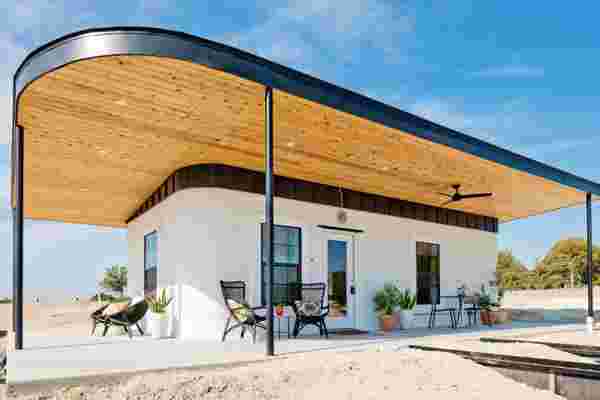
Nowadays almost everything is being 3D printed , so why should architecture be an exception? Many architectural firms are adopting 3D printing as their preferred technique to build structures. And 3D printed architecture is slowly but surely gaining a lot of popularity and momentum. This emerging trend is paving a path for itself in modern architecture. And I mean, no wonder, it has a ton of benefits! It’s a simple, efficient, and innovative technique that lowers the risks of errors, and also manages to save on time. 3D printing eradicates a lot of tedious steps during the construction process and simplifies it. It is being used to build homes, habitats on Mars, and even floating islands! The potential and possibilities of 3D printing in architecture are endless and mind-blowing. We’ve curated a collection of 3D-printed architectural structures that are our absolute favorites – from 3D printed sustainable office pods to a 3D printed housing community for the homeless, every single one of these designs unleashes the magic and potential of 3D printing!
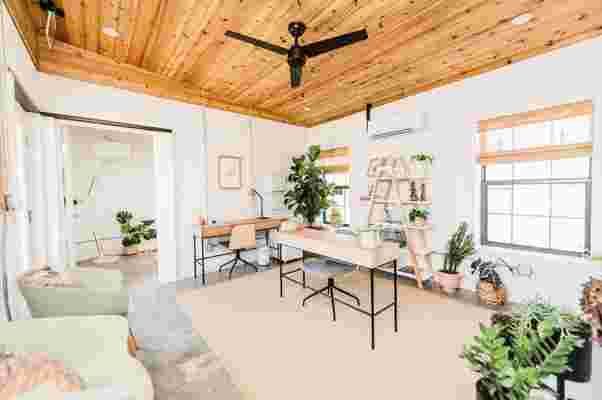
ICON 3D printed a 500 square foot structure which only took 27 hours of labor to construct. It will function as a welcome center at Austin’s Community First! Village – which will serve as affordable housing for men and women coming out of chronic homelessness. Six more 3D printed homes will be added to the development by ICON! The homes will be built using a proprietary concrete called Lavacrete, alongside the use of automated machinery and advanced software. The newly printed house features accents of black, white, and natural wood, creating a clean and minimal space that is aesthetic to live in!
Haue is a 3D printed luxury smart home that lets you live off-grid almost anywhere! The fully autonomous home is solar-powered and has been amped with an air-to-water generator which is hooked to a purification system, as well as a bioactive sewage system. The 400 square meter unit is prefabricated and comes equipped with smart systems, built-in furniture, and highly functional appliances. Though the price tag is slightly higher than usual 3D printed structures, but that’s because it’s being aimed at the luxury market. It’s a luxury vacation home you can set up anywhere!
Meet the Denizen Architype pod – a smart, functional, personal office that supports your remote work life and also could double up as a creative escape! This prefabricated office is designed with everything you need for the perfect workday and you can set it up anywhere in the world if you have subscribed to it – it’s like Netflix but for a physical office space. Denizen pods want to help reduce central office costs while adapting to the changes like remote work and flexible lifestyles. The 100 sqft pod is a modern solution with a small footprint that can help retain global talent, maximize productivity and reduce the environmental impact that big corporate offices have.
Designed by Dutch architects Houben & Van Mierlo , this boulder-shaped home in the Netherlands had its tenants move into it on 30th April, making it the first lived-in 3D printed house in the country! The single-story home was built as a part of a 3D printing scheme called Project Milestone. It is supposed to be the first 3D printed home in Europe where people actually reside! The tenants say the house has the feel of a bunker and feels safe. With curved sloped walls and floor-to-ceiling windows, the home is an open and warm living space.
DUS Architects created a 3D-printed tiny home in Amsterdam! Called the Urban Cabin, the little retreat is made of a bio-plastic, that has been crafted from linseed oil. This particular bio-plastic can be shredded and recycled into a new project, hence making the 3D printed home recyclable! It occupies only 90 square feet and is concrete-filled. A sculptural bathtub is placed alongside the home, and it is 3D printed as well. The super cute home is a true urban retreat, placed along a riverside, with an adorable bathtub to lounge about in. It’s a tiny home straight out of a fairytale!
TECLA is a completely 3D printed global habitat based on natural materials. TECLA’s construction started as a prototype in 2019 near Bologna, Italy as a response to pressing societal issues of explosive population growth which inevitably led to a lack of affordable accommodation. TECLA is created using entirely reusable, recyclable materials taken from the local terrain – it aims to be a model for circular housing as well as eco-housing. The habitat has been designed by Mario Cucinella Architects and brought to life by WASP’s engineering and printing tech. TECLA is set to be the first house to be entirely 3D-printed using locally sourced clay which has been used for centuries in countries like India as a cost-effective and environmentally friendly alternative to cement – clay is biodegradable and recyclable material that will make the building a zero-waste structure.
Mighty Buildings designed 3D printed homes that can be built with 95% fewer labor hours, and at twice the speed of a traditionl construction process. The company creates these prefab homes using their Big-G printer – a 20-foot tall 3D printer that functions at the speed of 120 millimeters per second. The structures have been constructed from Light Stone, a thermoset composite material (it hardens when exposed to UV light). The homes are quite stylish and elegant. They are usually around 700 square feet and equipped with a single bedroom, a kitchenette, a bath, and a walk-in closet.
DUS Architects built a 3D-printed canal house in Amsterdam! The components for the full-size canal house were printed on-site via a purpose-built printer called KamerMaker. The house was built alongside the Buiksloter-canal, acting as a research hub for 3D printed architecture. Each room in the canal house has been dedicated to a research theme. There is a ‘cook room’, wherein researchers will experiment with 3D printing with potato starch, whereas another room has been deemed ‘policy room’, where discussions regarding permits and how to obtain them, are carried out. Pretty cool, no?
In making R-IGLO , ArchiTech Company joined arms with Royal 3D to create igloo-like workspaces that are made from recycled PET plastic, a material that can be reused plenty of times over. Currently undergoing redevelopment, an important harbor in Rotterdam called M4H is where the team behind R-IGLO sources all the material used during the 3D printing process. Once the materials needed for printing are acquired, the construction of each R-IGLO workspace takes place in M4H as well. The R-IGLO units are built by linking together 3D-printed panels that can later be disassembled, stored, and transported just as easily as they were put together. Since each R-IGLO structure comprises several modules, owners can decrease or increase the size of their R-IGLO by swapping out different sized modules.
Designed as a series of modular islands that can transform any waterfront into a public space, Reeform aims at supporting life on land as well as underwater. A portmanteau of the words Reef and Form, the floating island comes with a two-part design. The upper half is designed as a hexagonal floating platform crafted entirely from recycled plastic, while the lower half bio-mimics the design of corals, using 3D printed concrete and calcite. As a result, both the upper and lower halves act as areas of interest for humans and marine life alike. Humans can use the modular platforms to create social spaces on water bodies like riverfronts, lakes, or pools, while the coral-inspired lower half helps reduce ocean acidification.
Imagineering L.A.’s Mass Transportation
On March 21, SCI-Arc’s SCI-FI program and The Architect’s Newspaper announced the winners of their open ideas competition, A New Infrastructure: Innovative Transit Solutions for Los Angeles .
The competition, inspired by LA County Measure R —a half-cent sales tax hike that promises up to $40 billion in transit funding for the city— attracted 75 proposals from around the world. It offered architects, engineers, urban planners, and students a chance to propose new ideas for the city’s transit infrastructure. Their entries focused on specific rail extension projects in the city and also take a look at larger-scale, interrelated planning challenges.
The competition jury included architects Thom Mayne, Eric Owen Moss, and Neil Denari; Aspet Davidian, director, Project Engineering Facilities, LA County Metropolitan Transportation Authority; Cecilia V. Estolano, chief executive officer, CRA/LA; Gail Goldberg, director of planning, City of Los Angeles; Roland Genik, urban planner and transit designer; and Geoff Wardle, director, Advanced Mobility Research at Art Center College of Design.
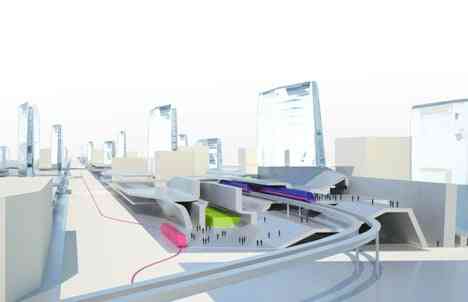
First Prize: Más Transit
Joshua G. Stein/RadicalCraft, Aaron Whelton/AAW Studio, and Jaclyn Thomforde with Jacob M. Brostoff
Más is regional high-speed rail for Los Angeles with a landscape to match. Promoting dense, organic development, it diversifies the communities in the built environment, making travel less necessary, easier and more predictable, and bypassing roadway congestion through a new raised infrastructure. Looping around the city, with connections to subways and buses, Más links local and inter-regional commuting; providing frequent service that will also sync up with the California High Speed Rail network. San Diego via más is less than an hour away, including transfer times; San Francisco is less than three hours away.
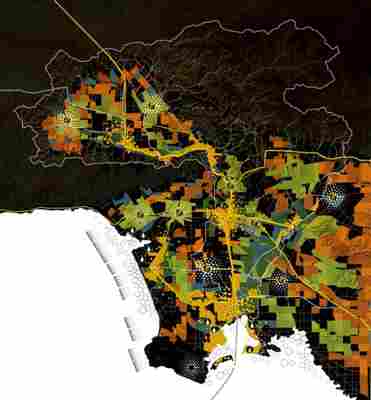
Second Prize: Infrastructural Armature
Fletcher Studio: David Fletcher, Dylan Barlow, Ryan Chandler, Daniel Phillips, Tobi Adamolekun
Recognizing the vital role that mobility, water, and sewage will play in Los Angeles’ future, the city must begin to invest in a core armature of new bundled infrastructures which will allow the city to survive the impending reality of peak water and peak oil. The city must reorganize along the matrices of transportation, water and sewer networks, and grow infrastructural tentacles out into the world to ship and receive.
Third Prize: Mag Luv
Osborn: Holly Chisholm, Kate Harvey, Armen Isagholi, Takeshi Kobayashi, Michael Pinto, Jared Sopko, Esmeralda Ward, Yuju Yeo
The scheme proposes eroding a portion of the freeway and supplanting it with a new object, mode, and form for adoration—Mag Luv. The high speed magnetic levitation peripheral train appropriates freeway, right of way, and “dream space” to become the mega structure of the Los Angeles transit system. The loop circumnavigates the city providing 12 hubs of activity, transportation, and power production.
Via: Archpaper & Arch Daily
This 3D printed cabin was designed to give you an escape from the everyday urban lifestyle!
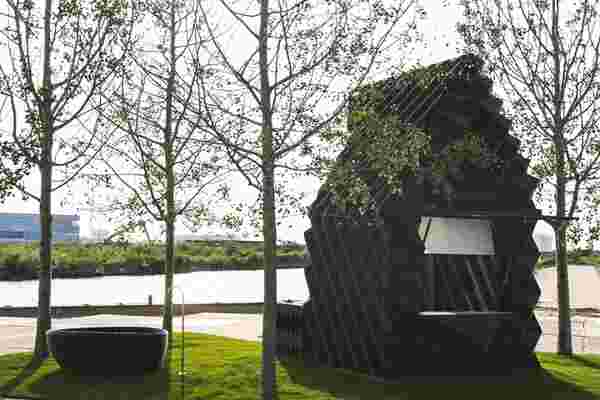
If you are looking for an unconventional staycation, this 3D-printed Urban Cabin could be it! It has transformed a former industrial area in Amsterdam from a vast empty space into an urban retreat with a pocket park for picnics and an outdoor bathtub that will teach you to not focus on what others might be thinking. The compact sustainable dwelling is actually born from research about building in urban environments. It is entirely 3D printed with bio-plastic and can be fully recycled to be reprinted in the future!
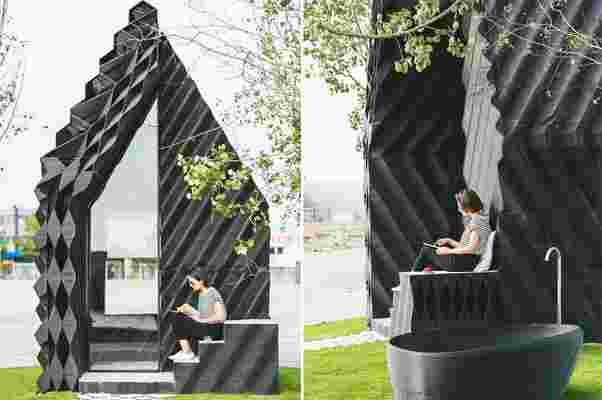
The compact sustainable dwelling is actually born from research about building in urban environments by Amsterdam-based firm Dus Architects. DUS designs indoor and outdoor furniture, interiors, and architectural installations using 3D printing to accelerate a new way of building – smart, 100% circular, and on-demand.
The cabin’s design plays with the relationship between indoor and outdoor spaces, it creates luxury with a minimum footprint. It is 100% 3D printed with black-colored bio-based material and showcases different types of façade ornament, form-optimization techniques, and smart solutions for insulation and material consumption. The floor and stepped porch offer a visual contrast, they are made with a concrete finish creating a beautiful pattern that extends into a path in the pocket park. In the green surrounding the cabin, you can enjoy the sculptural printed bathtub and watch the sunset admist waving poplar trees.
The 8 m2 x 25 m3 house fits the tiny house movement which is all about small structures solving large housing issues. The layout features a mini-porch and indoor space in which a sofa can be doubled up as a twin bed. The 3D printing techniques can be used particularly well for small temporary homes or in disaster-hit areas. After use, the bio print material can be shredded entirely and re-printed into new designs.
The Urban Cabin is part of the 3D Print Living Lab by DUS architects. It is another step in using the in-house developed 3D print technology to build sustainable, customizable, and fast housing solutions for the growing cities around the globe without having to dig deep foundations or generate massive construction waste.
The 3D Printed Urban Cabin rethinks intimacy and individual space within the city. We often don’t have the luxury of bathtubs or personal parks when living in a small city apartment but with precise insertion, innovation, and thinking outside the box, DUS managed to change the former industrial area from a vast empty non-place into a retreat to escape the speed of everyday life and to enjoy summer, the waterfront, and the sunset with friends or by yourself.
“The Summer House is the first step in using our 3D print technology in developing sustainable, customizable, and on-demand housing solutions for the fast-growing cities around the globe,” says the team that is known for keeping sustainability at the core of their urban development plans.
In its drive to democratize architecture, DUS founded Aectual, the design-to-build platform that brings smart & circular customizable 3D printed architecture solutions by and for architects, designers, and design lovers.
Through design, DUS builds alliances and solutions to create a big positive impact for our planet, it is all about acting with a global mindset – what benefits one city can benefit many more and that is how we can make a difference. Urban Cabin truly offers a unique perspective into urban architecture, sustainable construction, and a one-of-a-kind experience in your own city!
Designer: DUS architects








